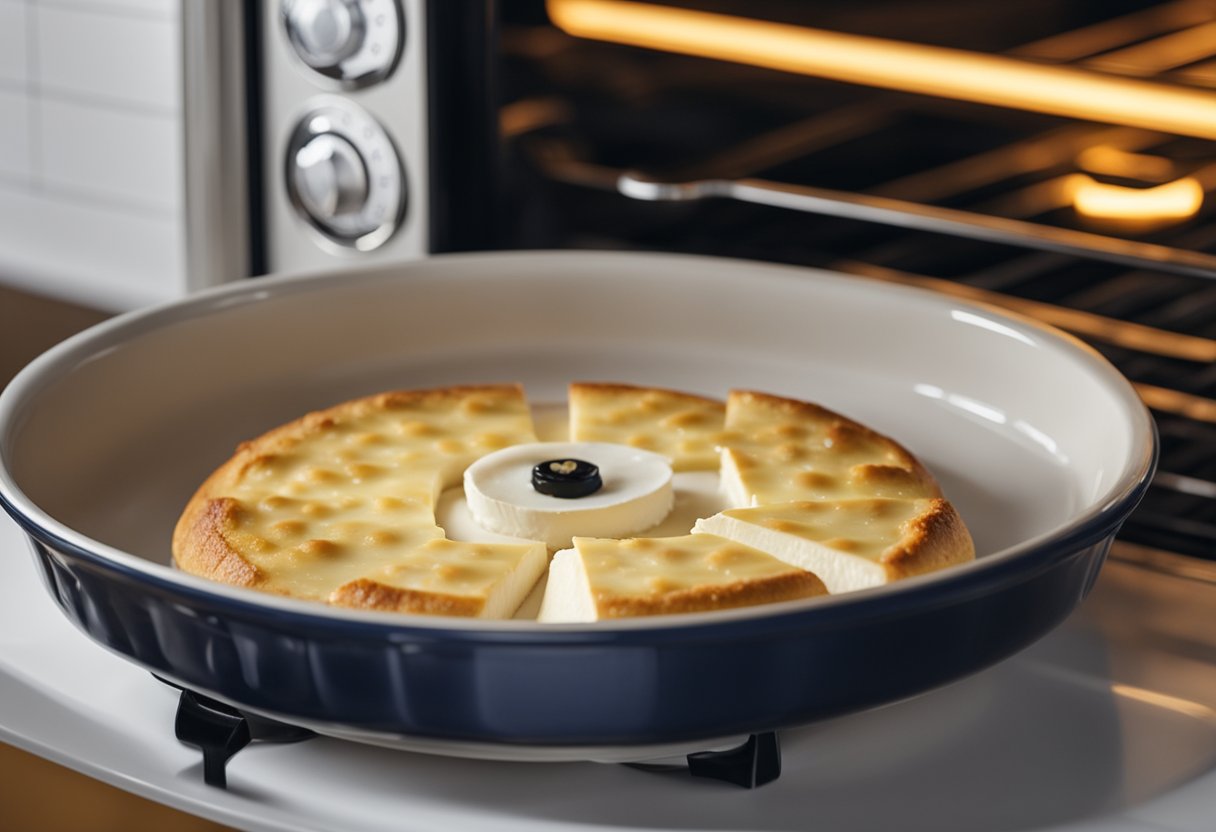Thawing cheese can be a tricky task. Whether you froze it for later use or accidentally left it in the freezer, it’s important to know the proper way to thaw cheese to maintain its taste and texture.
Improper thawing can cause the cheese to become mushy, dry, or even inedible. In this article, I will provide you with the necessary information to properly thaw cheese and enjoy it to its fullest.

Firstly, it’s important to understand the different types of cheese and their characteristics. Soft cheeses like Brie and Camembert are more delicate and prone to damage during the thawing process, while hard cheeses like cheddar and Parmesan are more durable.
Proper packaging and storage before freezing can also affect the quality of the cheese after thawing. Understanding these factors can help you choose the best thawing method for your specific cheese.
Key Takeaways
- Properly thawing cheese is crucial for maintaining its taste and texture
- Different types of cheese have different characteristics that affect the thawing process
- Proper packaging and storage before freezing can also impact the quality of the cheese after thawing
Types of Cheese and Their Characteristics

When it comes to cheese, there are many different types to choose from. Each type of cheese has its own unique texture, taste, and consistency that make it perfect for different dishes and occasions. In this section, I will discuss the characteristics of the most popular types of cheese.
Hard Cheeses
Hard cheeses are typically aged for longer periods of time, which gives them a sharper, more intense flavor. They are also usually crumbly in texture and can be grated or shaved for use in recipes. Some of the most popular hard cheeses include:
- Parmesan: A hard, nutty cheese that is often grated over pasta dishes.
- Cheddar: A sharp, tangy cheese that is perfect for snacking or melting on sandwiches.
- Jack: A mild, creamy cheese that is often used in Mexican cuisine.
- Romano: A hard, salty cheese that is often used in Italian dishes.
Soft Cheeses
Soft cheeses have a creamy, spreadable texture and a milder flavor than hard cheeses. They are often used as a spread on crackers or bread, or as a topping for salads and other dishes. Some of the most popular soft cheeses include:
- Brie: A soft, buttery cheese that is often served with fruit and crackers.
- Camembert: A rich, creamy cheese that pairs well with bread and wine.
- Ricotta: A mild, creamy cheese that is often used in Italian dishes.
- American Cheese: A processed cheese that is often used in sandwiches and burgers.
It’s important to note that while some types of cheese can be frozen, the texture and consistency may change when they are thawed. Hard cheeses, in particular, tend to freeze well and can be grated or shaved for use in recipes. Soft cheeses, on the other hand, may become crumbly or grainy after being frozen.
In summary, there are many different types of cheese to choose from, each with its own unique characteristics. Whether you prefer a sharp, tangy cheddar or a creamy, buttery brie, there is a cheese out there that is perfect for your taste buds.
Proper Packaging and Storage
When it comes to thawing cheese, proper packaging and storage play a crucial role in maintaining its quality and flavor. As a cheese lover, I have learned through experience that the right packaging and storage can make all the difference in the world. Here are some tips to help you keep your cheese fresh and delicious:
Refrigeration is Key
First and foremost, it’s important to store cheese in the refrigerator. Cheese is a perishable item, and refrigeration helps slow down the growth of bacteria, which can cause spoilage. Ideally, cheese should be stored at a temperature of 34 to 38 degrees Fahrenheit.
For best results, store cheese in the vegetable or cheese drawer, as it tends to be cooler, and the humidity is good for the cheese.
Proper Packaging
The packaging you choose for your cheese is also important. Cheese should be stored in an airtight container or wrapped tightly in plastic wrap or aluminum foil to prevent air from getting in.
This will help prevent the cheese from drying out and developing freezer burn. If the cheese comes in its original packaging, it’s best to keep it in that packaging until you’re ready to use it.
Freezing Cheese
If you’re planning to freeze cheese, it’s important to wrap it tightly in plastic wrap or aluminum foil and then place it in an airtight container.
This will help prevent freezer burn and extend the shelf life of the cheese. When thawing frozen cheese, it’s best to transfer it to the refrigerator and let it thaw slowly overnight. Avoid thawing cheese at room temperature, as it can lead to texture and flavor changes.
Shelf Life
The shelf life of cheese varies depending on the type of cheese and how it’s stored. Generally, hard cheeses like cheddar and parmesan can last up to six months in the refrigerator, while soft cheeses like brie and camembert should be consumed within a week or two.
Blue cheeses like gorgonzola and roquefort can last up to four weeks in the refrigerator. It’s important to check the expiration date on the packaging and consume the cheese before it goes bad.
In conclusion, proper packaging and storage are essential for maintaining the quality and flavor of cheese. By following these simple tips, you can enjoy your cheese for longer and avoid unnecessary waste.
Freezing Process
When it comes to freezing cheese, it’s important to do it correctly to avoid ruining the texture and taste of the cheese. Freezing cheese can help extend its shelf life for up to six months, but it’s important to know the right way to do it.
The first step to freezing cheese is to wrap it tightly in plastic wrap or aluminum foil. It’s important to remove as much air as possible to prevent freezer burn and the formation of ice crystals. Freezer burn occurs when the cheese is exposed to air, which causes it to dry out and form a tough, leathery texture.
Ice crystals can also form when the cheese is exposed to fluctuating temperatures, which can damage the protein structure of the cheese.
Once the cheese is wrapped tightly, it can be placed in the freezer. It’s important to note that the temperature of the freezer should be set to 0°F (-18°C) or lower to ensure that the cheese freezes properly. If the temperature is too high, the cheese may not freeze completely, which can cause it to spoil faster.
When it comes to thawing frozen cheese, it’s important to do it slowly to prevent the formation of ice crystals. The best way to thaw frozen cheese is to place it in the refrigerator overnight. This allows the cheese to thaw slowly and evenly, which helps to preserve its texture and taste.
In summary, freezing cheese can help extend its shelf life, but it’s important to do it correctly to avoid ruining the texture and taste of the cheese.
Wrapping the cheese tightly and storing it in a freezer set to 0°F (-18°C) or lower can help prevent freezer burn and the formation of ice crystals. Thawing frozen cheese slowly in the refrigerator is the best way to preserve its texture and taste.
Thawing Process
https://www.youtube.com/watch?v=5fSt-fIfcxI
When it comes to thawing cheese, there are a few methods that can be used. The most common methods are refrigerator thawing, room temperature thawing, and microwave thawing.
Each method has its own pros and cons, and it’s important to choose the method that works best for the type of cheese you’re thawing.
Refrigerator Thawing
Refrigerator thawing is the safest method to thaw cheese. This method is recommended for most types of cheese, especially soft cheeses like cream cheese.
To thaw cheese in the refrigerator, place the cheese in its original packaging or airtight container and put it in the refrigerator. The cheese will slowly thaw in the refrigerator over the course of several hours or overnight.
The slow thawing process helps to preserve the quality and texture of the cheese. It’s important to note that this method may take longer than other methods, but it’s the safest way to thaw cheese without compromising its quality.
Room Temperature Thawing
Room temperature thawing is another method that can be used to thaw cheese. This method is best for harder cheeses like cheddar or gouda.
To thaw cheese at room temperature, remove the cheese from its packaging and place it on a plate or cutting board. Leave the cheese at room temperature for a few hours until it’s completely thawed.
It’s important to note that room temperature thawing can be risky, as it can cause the cheese to spoil if left out for too long. It’s recommended to only use this method if you plan on using the cheese immediately after it’s thawed.
Microwave Thawing
Microwave thawing is the quickest method to thaw cheese, but it’s also the riskiest. To thaw cheese in the microwave, place the cheese in a microwave-safe container and microwave it on the defrost setting for a few minutes. Be sure to check the cheese every 30 seconds to ensure it doesn’t overheat or melt.
It’s important to note that microwave thawing can cause the cheese to become rubbery or grainy, especially if it’s overheated. It’s recommended to only use this method if you’re in a hurry and plan on using the cheese immediately after it’s thawed.
In conclusion, the thawing method you choose depends on the type of cheese you’re thawing and how quickly you need it.
Refrigerator thawing is the safest method, while room temperature thawing and microwave thawing are quicker but riskier methods. Be sure to choose the method that works best for your needs and always handle thawed cheese with care.
Reusing and Refreezing Cheese

When it comes to thawing cheese, it’s important to note that refreezing cheese is not recommended. Refreezing cheese can lead to a degradation in taste and texture.
However, if you have a large block of cheese and don’t plan on using it all at once, you can freeze it in portions to prevent unnecessary thawing and refreezing.
If you do decide to refreeze cheese, it’s important to note that the texture of the cheese will change and it may experience moisture loss.
This can cause the cheese to become crumbly or grainy, which may not be desirable for certain dishes. However, properly refrozen cheese can still be safe to consume for up to 6 months.
To safely thaw frozen cheese, it’s recommended to thaw it slowly in the refrigerator or at room temperature. Thawing cheese too quickly can cause it to spoil or develop an off-flavor.
If you need to thaw cheese quickly, you can use a microwave, but be sure to use a low power setting and check the cheese frequently to prevent it from melting.
In conclusion, while refreezing cheese is not recommended, if you do decide to refreeze cheese, be aware that it may experience texture change and moisture loss. Properly refrozen cheese can still be safe to consume for up to 6 months. To safely thaw frozen cheese, it’s recommended to thaw it slowly in the refrigerator or at room temperature.
Effects on Taste and Texture
When it comes to thawing cheese, the effects on taste and texture can vary depending on the type of cheese. Cheese that is high in moisture, such as fresh mozzarella or feta, can become mushy and lose its shape when thawed. On the other hand, hard cheeses like cheddar or Parmesan can become crumbly and dry.
One of the main effects of thawing cheese is a change in texture. Freezing causes ice crystals to form within the cheese, which can lead to moisture loss and a change in texture. Soft cheeses may become grainy or mealy, while hard cheeses may become brittle or crumbly.
In addition to texture changes, thawing can also affect the taste and flavor of cheese. Cheese that has been frozen and thawed may taste slightly different than fresh cheese. This is because freezing can cause enzymes in the cheese to break down, which can alter the taste and aroma of the cheese.
It’s important to note that not all cheeses are created equal when it comes to freezing and thawing.
Some cheeses, like Parmesan or cheddar, are more resilient and can withstand freezing and thawing without significant changes in texture or taste. Other cheeses, like fresh mozzarella or brie, are more delicate and may not fare as well.
Overall, the effects of thawing cheese on taste and texture can be significant, and it’s important to consider these factors when deciding whether to freeze cheese or not. If you do choose to freeze cheese, be sure to wrap it tightly and store it in a freezer-safe container to minimize moisture loss and prevent freezer burn.
Health Considerations

When it comes to thawing cheese, there are some important health considerations to keep in mind. Bacteria growth is a concern when it comes to thawing any type of food, including cheese. As such, it is important to thaw cheese safely to avoid any potential health risks.
Spoilage is another concern when it comes to cheese. Cheese that has been thawed and then refrozen can spoil more quickly, which can lead to food poisoning. It is best to avoid refreezing cheese if possible.
To ensure food safety, it is important to thaw cheese properly. Thawing cheese in the refrigerator is the safest method, as it allows the cheese to thaw slowly and evenly without reaching temperatures that are conducive to bacterial growth.
If you need to thaw cheese more quickly, you can use the cold water method. Place the cheese in a sealable plastic bag and submerge it in cold water. Change the water every 30 minutes until the cheese is thawed. However, this method should only be used if you plan to use the cheese immediately after it has thawed.
It is important to note that not all types of cheese can be frozen. Soft cheeses, such as brie and feta, do not freeze well and can become crumbly and dry when thawed. Hard and semi-hard cheeses, such as cheddar and gouda, are better suited to freezing.
In summary, when it comes to thawing cheese, it is important to prioritize food safety. Thaw cheese slowly in the refrigerator or use the cold water method if you need to thaw it more quickly. Avoid refreezing cheese to prevent spoilage and potential health risks.
Using Thawed Cheese
Once cheese has been successfully thawed, it can be used in a variety of dishes. Here are some ways I like to use thawed cheese:
Shredded Cheese
Thawed shredded cheese is great for adding to dishes like tacos, pizzas, and casseroles. I find that it melts just as well as fresh cheese, so it’s a great option for any recipe that calls for melted cheese.
Sliced Cheese
Thawed sliced cheese is perfect for sandwiches and burgers. I like to let the cheese come to room temperature before using it, as it can be a bit difficult to separate the slices when it’s still cold.
Baking Brie
Thawed baking brie can be used in any recipe that calls for baked brie. I like to top it with some honey and nuts before baking it in the oven. It’s a great appetizer for any party or gathering.
Soups
Thawed cheese can be added to soups to give them a creamy and cheesy texture. I like to add some shredded cheddar cheese to my broccoli cheddar soup for an extra cheesy flavor.
Bread
Thawed cheese can be used to make cheesy bread. I like to mix some shredded cheese with melted butter and garlic, and then spread it on a baguette before baking it in the oven.
Meat and Vegetables
Thawed cheese can be used to top meats and vegetables. I like to sprinkle some shredded cheese on top of grilled chicken or roasted vegetables for an extra burst of flavor.
Overall, thawed cheese can be used in almost any recipe that calls for cheese. Just make sure to let it come to room temperature before using it, and it should work just as well as fresh cheese.
Frequently Asked Questions
How to thaw shredded cheese?
The best way to thaw shredded cheese is to transfer it from the freezer to the refrigerator and let it thaw overnight. This method ensures that the cheese thaws evenly and retains its texture and flavor. If you need to thaw the cheese quickly, you can use a microwave.
Place the cheese in a microwave-safe bowl and heat it on the defrost setting for a few minutes. Be sure to stir the cheese every 30 seconds to prevent it from melting or clumping together.
Can you defrost cheese in water?
Yes, you can defrost cheese in water. To do this, place the cheese in a leak-proof plastic bag and submerge it in cold water.
Change the water every 30 minutes until the cheese is fully thawed. This method is faster than thawing in the refrigerator but can cause the cheese to become waterlogged and lose some of its flavor.
How to defrost mozzarella cheese in microwave?
To defrost mozzarella cheese in the microwave, place the cheese in a microwave-safe bowl and heat it on the defrost setting for a few minutes.
Be sure to stir the cheese every 30 seconds to prevent it from melting or clumping together. Once the cheese is thawed, use it immediately or store it in the refrigerator for up to 2 days.
Can you grate frozen cheese?
Yes, you can grate frozen cheese. However, frozen cheese is harder and more difficult to grate than fresh cheese. To make grating easier, let the cheese thaw in the refrigerator overnight or use a microwave to defrost it before grating.
How to defrost halloumi quickly?
To defrost halloumi quickly, place the cheese in a microwave-safe bowl and heat it on the defrost setting for a few minutes. Be sure to stir the cheese every 30 seconds to prevent it from melting or clumping together.
Once the cheese is thawed, use it immediately or store it in the refrigerator for up to 2 days.
How long does grated cheese take to defrost?
The time it takes to defrost grated cheese depends on the amount of cheese and the method of thawing. In general, it takes about 12-24 hours to thaw grated cheese in the refrigerator and a few minutes to thaw it in the microwave.
Be sure to stir the cheese every 30 seconds when defrosting in the microwave to prevent it from melting or clumping together.







